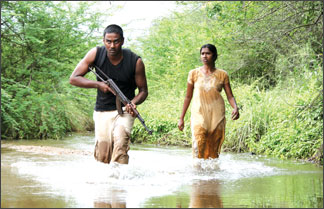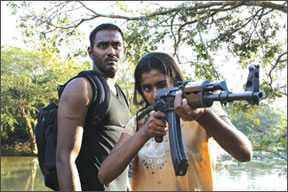Ilankai Tamil Sangam30th Year on the Web Association of Tamils of Sri Lanka in the USA |
|||||
 Home Home Archives Archives |
Road from Elephant Pass
Read the book review here. This is Chandran Rutnam's fourth directorial effort. Chandran is the CEO of a company that offers location services to Hollywood and Europe, and has been the line producer for movies such as Indiana Jones and the Temple of Doom, Indochine, Mother Teresa and Water to name some of the most well known. ------------------- The Sunday Observer, May 25, 2008 In an exclusive interview with the Sunday Observer, Film Producer and Director Chandran Rutnam, expresses his views on his latest production, “The Road from Elephant Pass” from Nihal De Silva’s Gratien Award winning novel. He considers the human relationships that transcends synthetic barriers of ethnicity, class, and creed as the core of the film. Here is an excerpt from the interview: Q: I found your script to be one of the most imposing and confrontational scripts which stands out as a true rendering of subtle human relationships. How did you manage to incorporate most of the details of the novel into the script?
A: The relationship between the two characters in the book, who were adversaries, was the important thread throughout the novel. They were able to express their deep concerns and beliefs to each other as they got more comfortable with each other. On-a-one to one personal level, they were able to argue each others case as they attempted to find answers deep within them. These are the basic issues that we are confronted with in this terrible conflict that Sri Lanka is enduring. This forces the audience to consider the issues. Q: How did you find the locations that resembled the north, since the journey begins in Pallai? A: I had the good fortune of having the services of Sri Lanka’s foremost Art Director, Sunil Wijeratne. Sunil has been the Production Designer and Art Director on all my Sinhala and international films. Q: What were the difficulties encountered in converting an Award winning novel into Cinema? A: When one decides to turn an Award wining novel into a motion picture, which also happens to be a best seller published in more than one language, there is a responsibility the film maker has to the writer and the material. I had to be very careful to be true to the essence of the novel. But, I had to omit some of the sequences which may have been interesting to the reader, but may slow the tempo of the motion picture. Nihal De Silva, was a wild life enthusiasts and a bird watcher. There were lovely wild life sequences in the book, but I have had to trim them down to get the story moving. I stuck to the relationship of the two characters that developed during their 9 day journey to Colombo. Together, they faced many adversaries and hardships, and were forced to depend on each other for mutual safety and security. These situations obviously brought them, either closer together or separated them further. At various times their relationship changes until they finally get to their destination. Q: Do you agree with the methods that have been employed by the novelist in striking home the relationship among diverse races and ethnicities? A: Yes I do. I believe that this came quite naturally to the author Nihal De Silva who was an extraordinary man. He respected every community and found luxury in the diversity. He used very subtle language and nuances. I tried to keep these within my script. I hope I was successful. Q: What is your view of the theme and about the conflict?
A: I will not comment on the conflict. Because we have rehashed this for a number of years, though, it was actually the theme that attracted me to the novel. Like Nihal I am also inspired and enjoy the texture of the diversities of people and culture. I enjoy my experiences in countries which are multi-cultural. India has that luxury of being a fascinating diversity of cultures, dialects and customs, all encompassed in one Indian nation. Q: Do you think that Sri Lankan audiences could comprehend the deep philosophical ideals embedded in the story line, or whether they take it as a mere story between a battle-hardened soldier, and a would-be informant? A: I have great faith in the intelligence of the Sri Lankan audience. Yes, they will comprehend the ‘philosophical ideas’ in the story. In some cases, it may be subconsciously. I feel that it will have a positive impact on the audience. It may create an environment where the audience may give thought and begin to ask questions. The book is in its eighth printing in English and has been translated into Sinhala titled ‘Alimankada Sita’. This is a definite indication that people are interested in the subject. Q: Though the plot appears to be simple, the author craftily amalgamates actors on each side of the divide, thus presenting the different polemics of the conflict. What are your views? A: The theme is simple. A story about two adversaries thrown together against the panorama of the Sri Lankan ethnic conflict, each with different beliefs, delving into each others phyche, and coming up with different opinions and assessments of the situation as it is or was. In the end, I do not believe that the problem was solved, nor did they have a definite idea or a conclusive resolution to their aspirations. The process is what is important. It is the process of the journey and what takes place between them during that journey, which is important. In the story line, among the other characters, language plays a prominent role in dividing a otherwise a harmonious population who share the same soil.
Q: Don’t you think that the gulf created by language between two ethnicities would have contributed in drawing them apart, confining them to the traditional polemics on either side of segregation? A: I do not want to get into the political aspect of the theme of the novel. In my opinion, as far as Sri Lanka is concerned, religion is not a segregator of communities. We Sri Lankans respect each others religion, which is obvious when one visits Kataragama or any of the other numerous places of worship throughout the island. I would say that it is possible that language may divide us. Q: The Road From Elephant Pass would be a different film to most of the cheap fantasies that unfortunately make an inroad in to the cinematic landscape of Sri Lanka. How can a serious film maker contribute to uplift the deteriorating artistic standards in Sri Lanka? A: Well, I do not place tags on film makers. First of all, if any one is going to make a movie, he or she better be serious, for the simple reason that he or she is spending some ones money. As far as a serious subject or what you call “cheap fantasies”, that is the choice of the Director, the Producer and any other sponsor of the project. If they find that they could get a financial reward by making films that are frivolous, and if they are successful in doing so, one cannot argue. There is certainly a place for good films. Somebody once asked, “What is wrong with the film industry?” The answer was “...there is nothing wrong with the film industry that a good film could not fix”. I do not feel that the ‘self styled psuedo intellectual films’ will succeed, owing to the fact that audiences are no longer naive, and could feel the falsity in the film. Film making is the most expensive art form, and it is also the most collaborative exercise. Numerous new good films are presently being made by talented local producers and directors. Q: Who are playing the two main roles in The Road From Elephant Pass? A: The captain is played by a wonderful young man, Ashan Dias. He is an excellent stage actor who really got into his part and has given a great performance. The girl Kamala, is played by Suranga Ranawaka, a new comer to films. I liked her look, the moment I saw her and felt that she would be ideal for the part. We have an excellent group playing important supporting roles. Joe Abeywickrema, Sanath Gunatillaka, Veena Jayakody, Irangani Serasinghe, Ranjith Wickremasinghe, Rohitha Manage, M. Rajeshwari and Kumar Mirchandani. Q: For a film with a backdrop of the conflict, you would have had to have the cooperation of the Ministry of Defence? A: The novel was awarded the ‘State Literary Prize’ in 2003, by HE the President of Sri Lanka. Yes, we had the support of the Ministry of Defence, as we needed Army vehicles and Air Force Helicopters in the film. I am very grateful for the cooperation extended by the Ministry of Defence, in the making of, The Road from Elephant Pass. Q: What are the new productions in line to come? A: I have formed a partnership with the Chairman of the ABC group of Companies - Shiran Dissanayake, called A.B.C Films (Pvt) Ltd. Jointly managed by Orville Pereira who handles the administrative and financial side and I am responsible for the creative aspect of the film production. A.B.C Films plans to make many films. The next production would be Rudyard Kipling’s “Toomai of the Elephants”, and to break in to the international English main stream market. It will be a co-production with a Hollywood Company. I am presently discussing a world wide distribution deal with Steven Speilberg’s Dreamworks family film section. We are also involved in the production of films with Indian producers, Satlluj Dheer and Yash Patnaik. Q: What part would Film Location Services play in these productions? A: Film Location Services is a production service company providing motion picture equipment and in-house professional expertise to the international motion picture industry. We are also involved in the production of Commercial and Documentaries. Film Location Services is presently involved in the pre production of a film to be produced by veteran Hollywood Producer, Paul Mason, and also the pre production of the epic story ‘Prince Siddartha’ to be produced by the Light of Asia Foundation and Beyond Dreams Inc. India. Q: Who are the Sinhala film makers you admire? A: Lester James Peries, Lester James Peries and Lester James Peries! |
||||
|
|||||
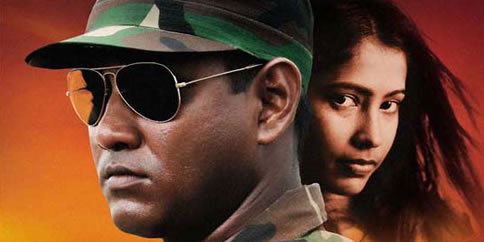 Based on the locally best selling novel by the late Nihal de Silva, The Road from Elephant Pass revolves around the love between a Tamil Tiger soldier and an officer from the official Sri Lankan army and was made by producer-director Chandran Rutnam. It premiered last October in Colombia after a two-minute silence as a mark of respect to the author, who was killed in 2006 in a landmine explosion in Wilpattu Park.
Based on the locally best selling novel by the late Nihal de Silva, The Road from Elephant Pass revolves around the love between a Tamil Tiger soldier and an officer from the official Sri Lankan army and was made by producer-director Chandran Rutnam. It premiered last October in Colombia after a two-minute silence as a mark of respect to the author, who was killed in 2006 in a landmine explosion in Wilpattu Park. 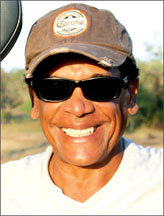
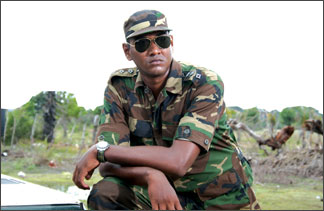 He selected some wonderful and exciting locations that suited the story, in Uddappuwa, Kalpitiya, Puttalam and Maho. Suminda Weerasinghe was the Cinematographer who captured the visual essence of the story.
He selected some wonderful and exciting locations that suited the story, in Uddappuwa, Kalpitiya, Puttalam and Maho. Suminda Weerasinghe was the Cinematographer who captured the visual essence of the story. 